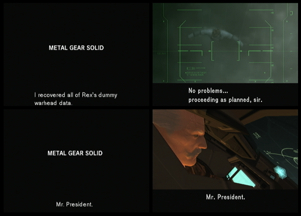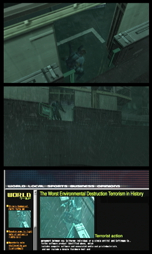And we drove off a cliff.
The Tanker Chapter denied the player all the rewards that MGS1 had taught him to expect. Snake fought no supersoldiers—only a pregnant woman with no special powers except a pistol. He discovered the new Metal Gear, but MGS1’s antagonists arrived with the terrorists, stole the machine, and appeared to kill Snake.

|
The Tanker Chapter inverted dramatic and gameplay tropes familiar to the Metal Gear series. Actors typically needed to procure their weapons on-site, and they cannot confiscate weapons from fallen enemies. Snake began his mission with a tranquilizer gun, and he salvaged a pistol when he defeated the tanker’s sole boss. These reversals changed MGS2’s formal player-actor relationship. Other Metal Gear games had made their actors rely upon the player for arms, yet the Tanker Chapter only gave the player weapons in-game through Snake’s narrative foresight and resourcefulness. The player controlled Snake less as an actor, and Snake’s decisions as a character determined the range of the player’s actions.
MGS2 inverted MGS1’s modus operandi—stealth infiltration. Ocelot had lured Snake aboard the tanker specifically so he could photograph Snake and publicize his presence. Snake’s infiltration of Shadow Moses Island in MGS1 had been publicized, and Snake had become a hero as a result; yet Ocelot publicized Snake’s presence onboard the Tanker to vilify him as a terrorist.

|
MGS2 had expanded MGS1’s core gameplay concept—its
basic formal element—to create a new Player Objective: hide the dead guards. The expansion
had seemed to affirm the Series
Map. However, when the player obeyed formally coherent Player Objectives, Snake failed his Actor Objectives without the redemption
that he had received in
MGS1.